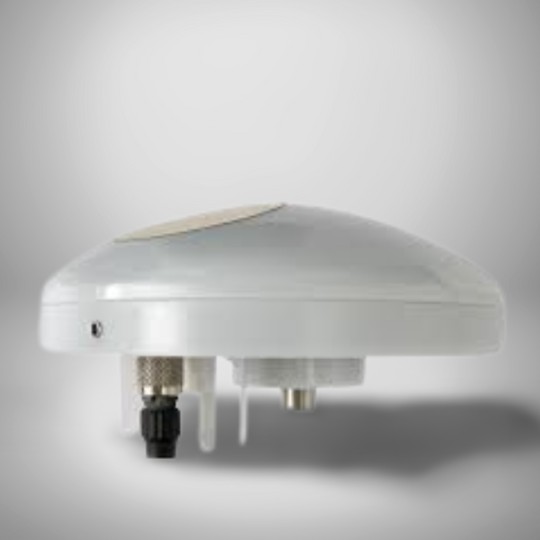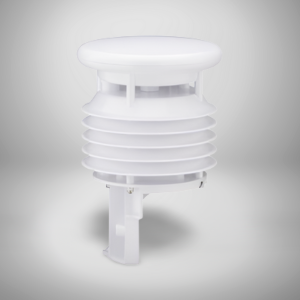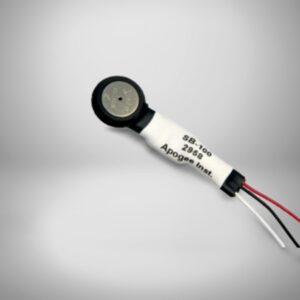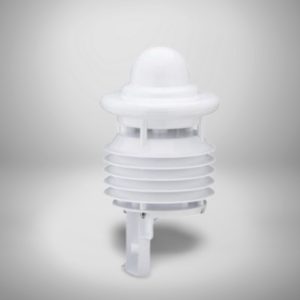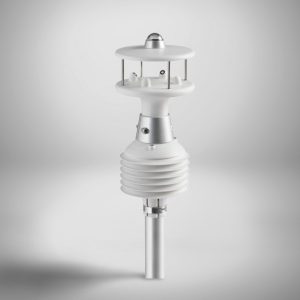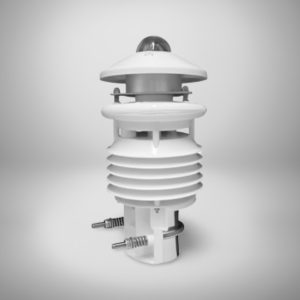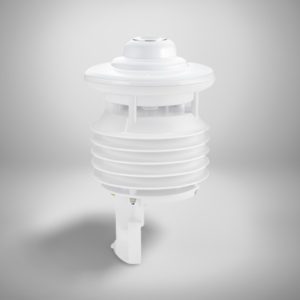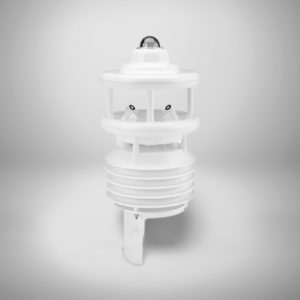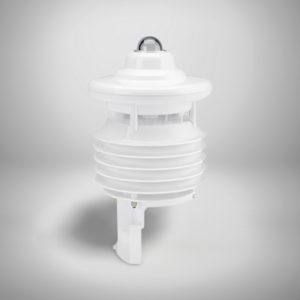WSC11-Compact Weather Sensor:
The interface for the instrument is digital and consists of an RS-485 interface. Together with ID-based communication, the interface facilitates the operation of the weather station in a bus.
The instrument has a GPS receiver. Its purpose is to determine position and time. In addition, the position of the sun is calculated here.
The following parameters can be measured: wind speed, wind direction, brightness (in North, East, South, and West), twilight, global radiation, precipitation, temperature, relative air humidity, air pressure, time/date, geostationary data, longitude, latitude, sun position, elevation, and azimuth.
Wind Speed and Direction: Wind measurement is based on the hot wire principle. The underside of the housing is equipped with a heated cylindrical sensor. A PID controller adjusts the temperature of the cylinder to a temperature that is constantly increasing in relation to the environment. The supplied heat energy is a measure of wind speed.
Brightness is measured using four Silicium photo sensors that are aligned to the four cardinal directions in the mean elevation angle.
Twilight: “Twilight” refers to the light diffusion in the atmosphere caused by the smooth transition from day to night before or after the start or end of the day. i.e., the solar disc is not visible. The twilight is direction-independent. It is calculated from the sum of the four measuring values of the direction-independent brightness sensors. Commands can be used to change the mean value of the four brightness values.
Global irradiance: A silicon PIN photodiode is used to measure global irradiance. The sensor is positioned horizontally and registers the diurnal values of the solar irradiation intensity.
Precipitation: The detection of precipitation is based on capacitance measurement, i.e., the capacity of the sensor surface varies when wet. The sensor is installed in the housing cover. An integrated heating system adjusts the sensor area to a higher temperature in relation to the ambient temperature. This overtemperature (approximately 2 K) prevents bedewing of the sensor surface. The thermal output increases with precipitation. This accelerates the drying of the sensor, allowing the time at which precipitation ended to be identified more accurately.
Air temperature: A PT1000 measuring resistor is used to measure the air temperature. The sensor is mounted on a flexible printed board and positioned in the lower section of the housing.
Air pressure: Absolute air pressure is measured with a piezoresistive MEMS sensor.
Time, date, and geostationary data: The weather station has a GPS receiver with a built-in RTC. This allows it to receive the position of the weather station (degree of longitude and latitude, local altitude), time (UTC), and date. The GPS receiver does not need alignment. The built-in RTC (Real Time Clock) is buffered with a backup capacitor and retains its data without a voltage supply for a minimum of 3 days.
Position of the sun (elevation and azimuth): On the basis of the GPS data, the current sun position is calculated every second.
Humidity measurement: A built-in hygro-thermosensor is used to measure humidity levels. The sensor has a small air exchange volume thanks to its compact design and responds to changes in humidity in seconds.
A software module uses the relative humidity and air temperature to calculate the absolute humidity and dew point temperature.
The temperature of the inside of the housing is measured by a silicon temperature sensor.
GPS-Receiver: The weather station has a GPS receiver with an integrated RTC (real-time clock) for receiving the position of the weather station and time and date (UTC). An alignment of the GPS receiver is not necessary. The integrated RTC is buffered for a period of 3 days.
Application and features of WSC11-Compact Weather Sensor:
Application |
Features |
|---|---|
| ✅ Building control system ✅ Traffic engineering ✅ Meteorology ✅ Energy supply ✅ Ecological monitoring |
✅ Compact construction ✅ Easy mounting ✅ Diverse options of data output. ✅ Real Time Data monitoring ✅ Data Accuracy |

